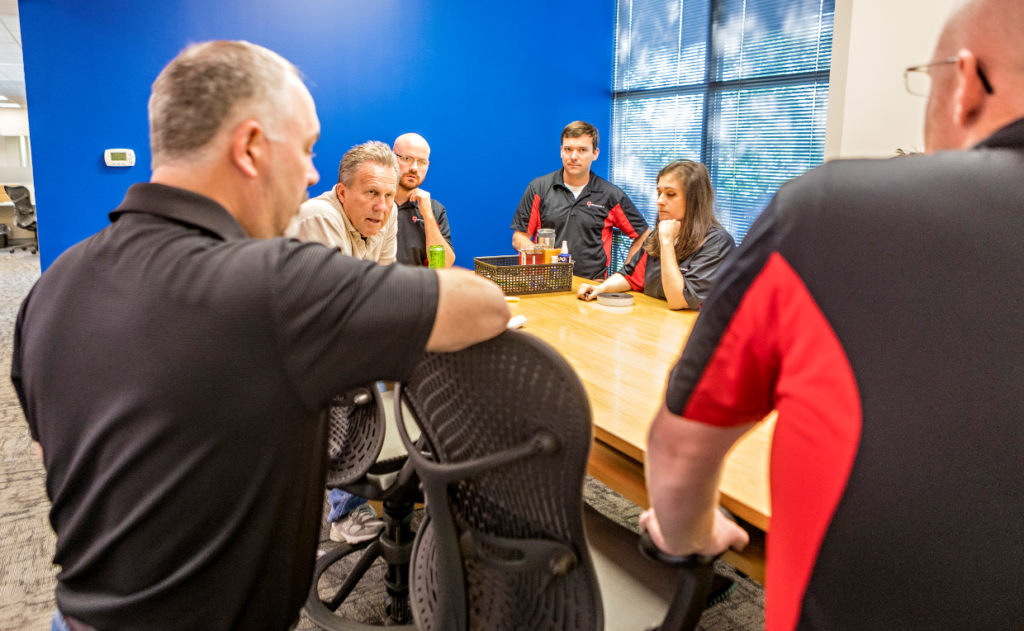Speeding problem-solving with LSP Mechanical Engineering
Customer-centered innovation, teamwork, and communication drives high-speed prototyping, design, and problem-solving
Posted: July 24, 2019
By:

Motorsports veteran Gary Grossenbacher leads LSPT mechanical engineering team with “Never say never” motto and an always-listening style
Customer-centered innovation drives the LSP Technologies Mechanical Engineering Team, and the group is one of the prime examples of how LSPT’s culture empowers high-speed prototyping, design, and problem-solving.
It’s an unending business transformation. In their work to develop new custom laser peening solutions, mechanical engineers engage in constant conversation, walking around, proactively identifying problems, and applying relentless energy in solving them.
Gary Grossenbacher, a veteran of 37 years in competitive motorsports racing, is LSPT’s chief mechanical engineer, and he relishes the chance to work with enthusiastic problem-solvers with a wide variety of skill sets. “That’s really what I appreciate, to walk around in groups that are efficient and nimble, quick-witted and think on their feet so that they can solve issues and change design.”
Enough challenges for everyone
The open floor plan at the new LSPT headquarters epitomizes the approach. Managers and engineers work elbow-to-elbow and across work tables and huddle spaces, overhearing each other’s conversations, looking over each other’s shoulders, and arriving at solutions together.
It’s an approach that gives new team members the opportunity to try new approaches, as well as the requisite confidence and courage.
“We bring people in and give them very challenging, very complex problems, and they’ve been very successful in short order, contributing significantly to our business and solving very challenging customer problems,” said Mark Bloomberg, VP – Engineering.
Addressing laser peening challenges
Although much of the ME team is young and new to LSPT, they have intense experiences behind them. Together, they’ve taken on cutting-edge assignments since they joined LSPT, most of them less than 18 months ago:
• Advanced tooling to deliver laser beams to hard-to-reach areas.
• New tooling to accommodate portable, lower-power laser delivery via fiber optics.
• Improved design for chiller, water and vacuum systems.
• Modular cell design to accommodate laser peening systems and robotic controls
• Understanding laser peening requirements for nuclear containment or environments with hazardous fuels and chemicals.
The art of project management for laser peening projects involves proving out concepts, refining them, selecting components and materials, integrating the technologies, and of course integrating the ME work with optics, controls, robotics, and adhering to required laser peening parameters – power levels, spot size, pulse rate, and pulse width.
For dedicated problem solvers, just add time and money
There are plenty of off-road racers, mountain bikers, classic car aficionados, motorcyclists, and garage tinkerers at LSP Technologies. But clearly Grossenbacher is a standout with decades of high-speed racing experience. “I grew up racing, was around racing, and when I graduated college (Arizona State University) it was what I wanted to do,” he said.
Nowadays, laser peening technology holds a strong appeal for Gary G, as he’s known. Lasers and auto engines have more in common than you might think. Both challenge you to learn something new every day.
Both fields also prove an engineering maxim that almost anything is possible, given enough time, resources, and dedicated thinkers. In developing first-of-a-kind laser projects the engineering staff often draws inspiration from other firsts, like the moon landing 50 years ago, breaking the sound barrier, or uncovering mysteries of the ocean depths.
“In auto racing, where I spent so many years, you never say you can’t do something,” Grossenbacher said. “It’s really a case of time and money. I think being blessed, being educated, and having a career in America, you recognize that we can pretty much do whatever we need to do or want to do if somebody’s willing to spend the time and the money to accomplish it.”
Laser peening now a solid return on investment
Fortunately, the core components of laser peening systems have improved in reliability and speed while coming down in cost, too. “In the past few years, laser peening systems have become more economically feasible to design, build, and operate. It’s much more in line to move from defense and aerospace to mainstream manufacturing,” Grossenbacher said.
Mechanical engineers on the team typically have been successful at one specialty, but then face challenges in another. “We have an electrical engineer who has made a rapid shift into mechanical work. We have experts in fluid management. And some mechanical engineers work in our controls or automation areas,” Grossenbacher said. “The cross-training activities are important, as well as the opportunity to learn new things and grow.”
Interested in Seeing More?
Tell us about your application, material, or failure mechanism and we will have one of our experts reach out to you. Our extensive library of research and years of experience gives us a unique advantage to apply a finite element analysis to help diagnose the best application for your situation.
